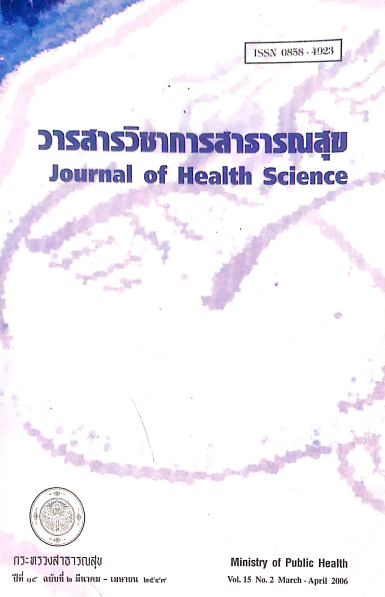สารเคมีและฤทธิ์ต้านอนุมูลอิสระในเครื่องดื่มชาเขียวพร้อมบริโภค
คำสำคัญ:
ฤทธิ์ต้านอนุมูลอิสระ, เครื่องดื่มชาเขียว, LC-ESI-MS-MS, catechins, คาเฟอีนบทคัดย่อ
การศึกษานี้มีวัตถุประสงค์เพื่อตรวจสอบฤทธิ์ต้านอนุมูลอิสระและหาปริมาณสารคาเฟอีนในเครื่องดื่มชาเขียว โดยเก็บตัวอย่างเครื่องดื่มชาเขียวพร้อมบริโภคในเดือนมกราคม ถึงพฤษภาคม ๒๕๔๘ รวม ๒๔ ตัวอย่าง จาก ๑๑ ผู้จำหน่าย จำแนกเป็นชาเขียวผสมน้ำผลไม้ จำนวน ๙ ตัวอย่าง ชาเขียวใส่นมจำนวน ๒ ตัวอย่าง และชาเขียวเปล่าจำนวน ๑๓ ตัวอย่าง นำมาประเมินฤทธิ์ในการต้านอนุมูลอิสระ ด้วยวิธี DPPH (diphenylpicrylhydrazyl) assay และหาสูตรโครงสร้างของสารที่มีฤทธิ์ในการต้านอนุมูลอิสระโดยใช้เครื่องวิเคราะห์ชนิดมวลโมเลกุลของสาร Liquid chromatography -electrospray ionization -mass spectrometer -mass spectrometer (LC-ESI-MS-MS) และหาปริมาณสารคาเฟอีน โดยใช้ High performance liquid chromatography (HPLC) ผลการประเมินฤทธิ์ในการต้านอนุมูลอิสระของเครื่องดื่มชาเขียวพบว่ามีฤทธิ์ในการต้านอนุมูลอิสระสูงกว่าร้อยละ ๘๐ จำนวน ๒๑ ตัวอย่าง (ร้อยละ ๘๗.๕) วิเคราะห์หาสารสำคัญในเครื่องดื่มชาเขียวเปล่าจำนวน ๑๓ ตัวอย่าง โดยสกัดด้วยสารเอทิลอะซิเตต (ethyl acetate) นำสารสกัดที่ได้ไปวิเคราะห์หาสาราสำคัญโดยฉีดเข้าระบบ LC-ESI-MS-MS แบบ flow injection analysis (FIA) ใช้สารละลายเฟสเคลื่อนที่ (mobile phase) เป็น acetonitrile: ๐.๑% formic acid, ๕๐.๕๐ v/v ในหมวด full scan negative ionization พบว่าเครื่องดื่มชาเขียวเปล่าทั้ง ๑๓ ตัวอย่าง มีมวลโมเลกุล [M-H]-1 ที่ m/z ๑๖๙, ๒๘๙, ๓๐๕, ๔๔๑ และ ๔๕๗ เมื่อแตกมวลโมเลกุล (fragmentation) โดยทำ product-ion scan เทียบกับสารมาตรฐานและข้อมูลที่มีรายงานมาแล้ว สารสำคัญที่พบในชาเขียวคือ gallic acid (GA), epicatechin (EC), epicatechin gallate (ECG), epigallocatechin (EGC) และ epigallocatechin gallate (EGCG) สำหรับปริมาณคาเฟอีนที่พบอยู่ในช่วง ๔-๑๗ มิลลิกรัม/๑๐๐ มิลลิลิตร มีค่าเฉลี่ย ๙.๗ มิลลิกรัม/๑๐๐ มิลลิลิตร
Downloads
ดาวน์โหลด
เผยแพร่แล้ว
วิธีการอ้างอิง
ฉบับ
บท
การอนุญาต
ลิขสิทธิ์ (c) 2019 วารสารวิชาการสาธารณสุข

This work is licensed under a Creative Commons Attribution-NonCommercial-NoDerivatives 4.0 International License.







